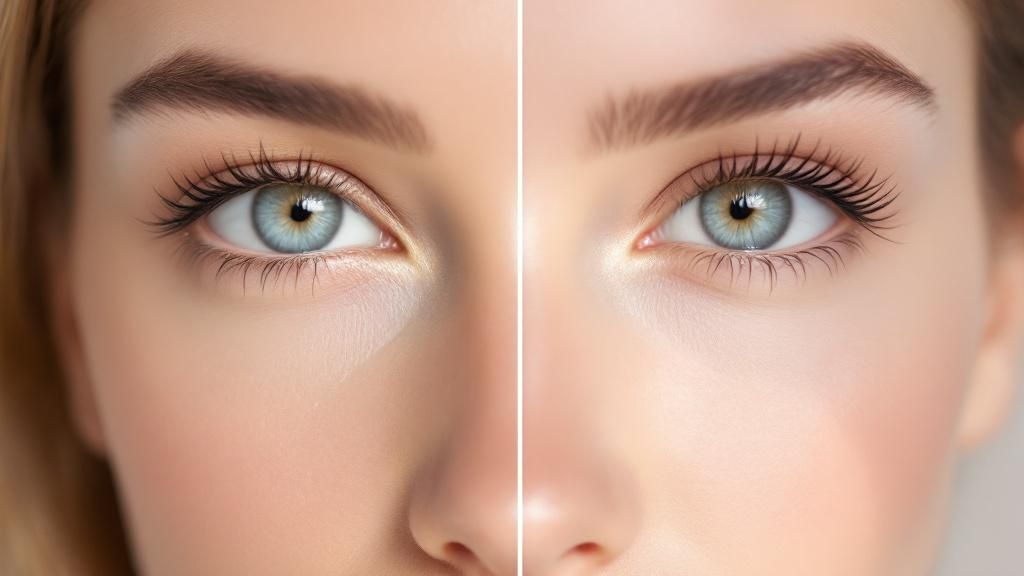
Let's get straight to the point. Under-eye bags are a frustrating mix of weakening skin, shifting fat pads, and stubborn fluid retention.
Think of the delicate skin under your eyes like a tiny, supportive hammock. Over time, or thanks to our genetics, that hammock loses its tension. The natural fat pads that cushion our eyes start to bulge forward, and that’s when the puffiness appears.
The Core Reasons for Under Eye Bags
So, what’s really behind those bags? While it’s easy to blame a single late night, the truth is a lot more complex. The puffiness you see is usually a combination of your natural facial structure, the inevitable aging process, and certain lifestyle habits that pour fuel on the fire.
These factors don't work in isolation—they team up to change how that delicate area looks and feels. For most of us, it’s not one culprit but several working together.
Key Contributing Factors
To get a handle on under-eye bags, you first need to know what you’re up against. Here are the three main drivers:
- Aging and Collagen Loss: As we get older, our bodies slow down the production of collagen and elastin—the proteins that act like scaffolding for our skin, keeping it firm and bouncy. When their levels drop, the tissues supporting the eyelids weaken. This allows the fat that normally sits behind the eye to droop forward, creating that noticeable bulge.
- Genetics and Anatomy: You can often thank your parents for this one. Your inherited facial structure—like the shape of your eye sockets or the height of your cheekbones—can create natural hollows and shadows that make bags look more prominent. If under-eye bags run in your family, you're much more likely to have them, too.
- Lifestyle and Environmental Triggers: Your daily habits have a huge impact. A high-salt diet is a classic example; it makes your body hold onto water, leading to puffiness all over, especially under the eyes. Likewise, poor sleep, seasonal allergies, and sun damage all play a major role in making bags worse.
The infographic below shows how all these pieces fit together.
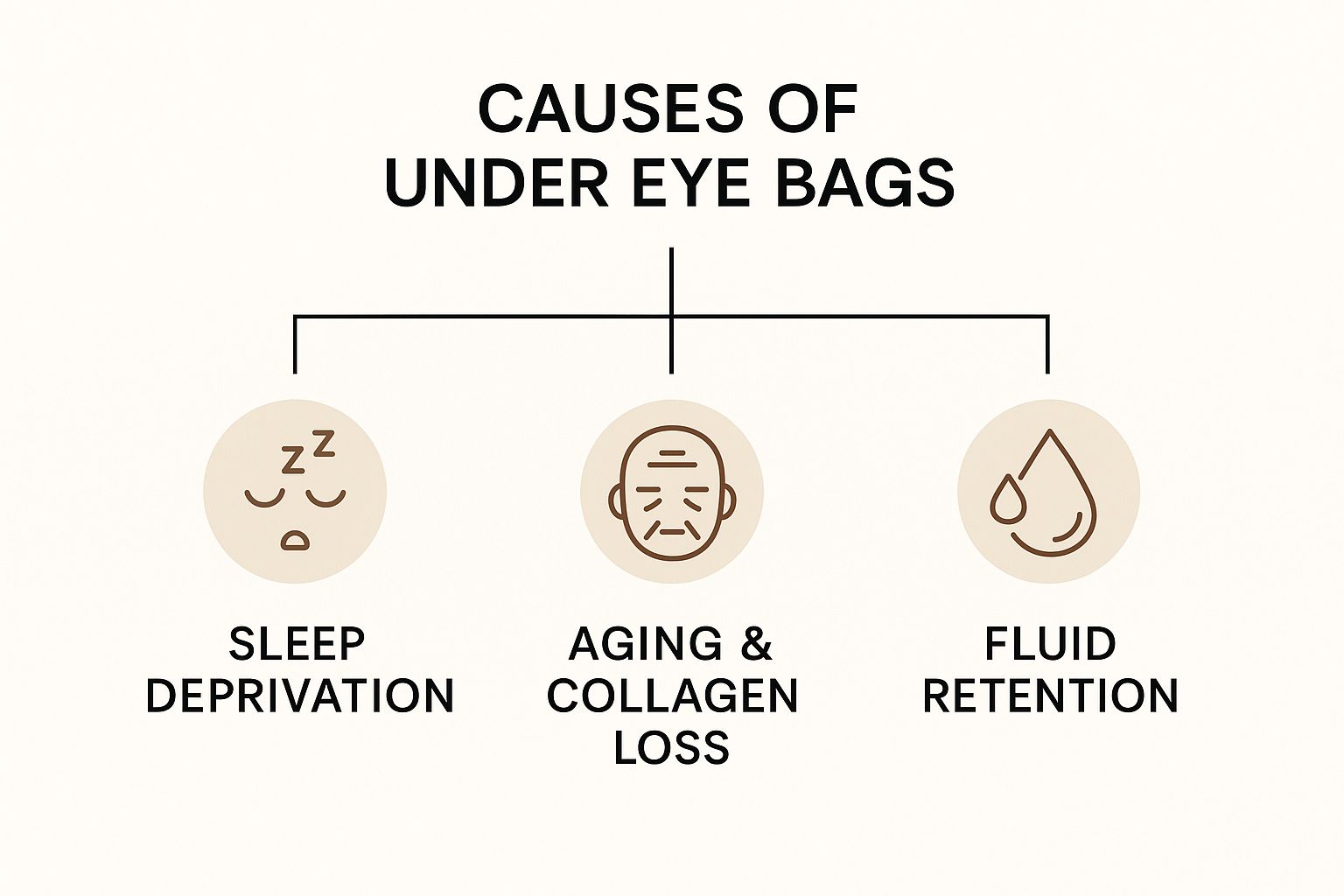
As you can see, while aging lays the foundation, it’s those external factors like sleep and diet that really dictate how noticeable the bags are day-to-day. To fight back, a targeted product like the BARB N.P. Eye Contour Cream can make a real difference by firming and deeply hydrating this delicate skin.
To make things even clearer, let's break down the main causes in a simple table.
Primary Causes of Under Eye Bags at a Glance
This table offers a quick summary of the main factors contributing to the appearance of bags under the eyes.
| Cause Category | Key Factors | Primary Effect |
|---|---|---|
| Biological Aging | Loss of collagen and elastin | Skin loses firmness, allowing fat to bulge forward. |
| Genetics | Inherited facial structure (bone structure, fat distribution) | Creates natural shadows and hollows that accentuate puffiness. |
| Lifestyle Choices | High-salt diet, poor sleep, dehydration | Causes fluid retention and inflammation, making bags look worse. |
| Environmental Factors | Sun exposure, allergies | Damages skin elasticity and triggers swelling. |
Understanding these distinct categories helps you see that tackling under-eye bags requires a multi-faceted approach—addressing not just what you put on your skin, but how you live your life.
Why Aging Is the Biggest Factor Behind Under-Eye Bags
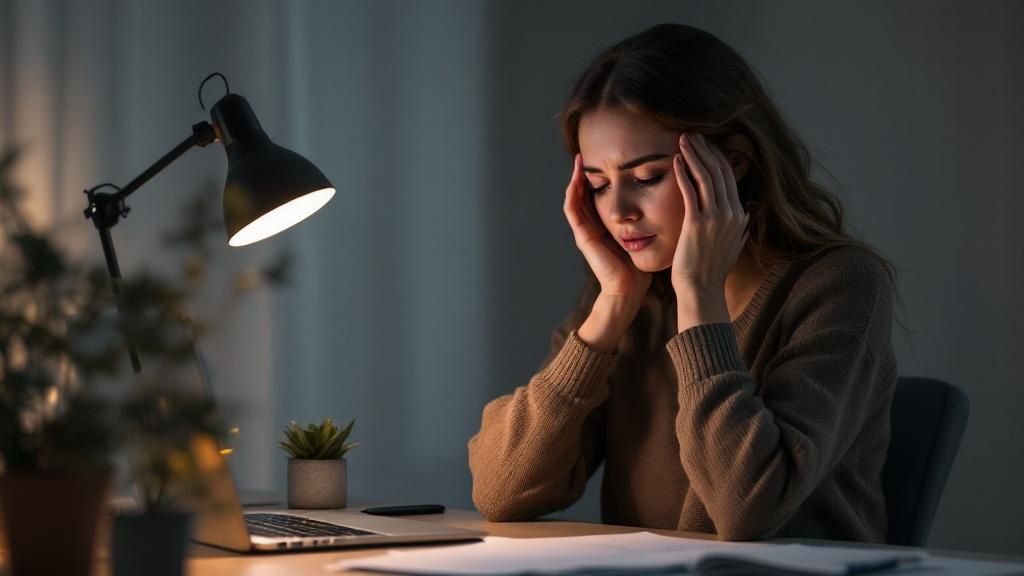
We often blame late nights or salty snacks for those pesky bags under our eyes, and while they don't help, the real culprit is usually just time itself. As we get older, our bodies naturally slow down the production of collagen and elastin—the two proteins that act like scaffolding for our skin, keeping it firm, plump, and bouncy.
Think of the delicate structure supporting your eyelids like a brand-new, tightly woven hammock. In our youth, it’s strong and supportive, holding everything exactly where it should be. But over the years, that hammock naturally starts to lose its tension and sag a bit.
This weakening is a normal part of the aging process. It allows the protective fat pads that cushion our eyes to drift downward and forward. The result? That puffy, bulging look we call under-eye bags. It’s not that you've gained more fat; it has simply shifted because the support system isn't as robust as it once was.
The Role of Fluid Retention
On top of the structural changes, our bodies also manage fluid differently as we age. The skin under the eyes is already incredibly thin, and as it loses elasticity, it becomes even less effective at holding back excess fluid. This is why bags often look their worst first thing in the morning.
After you've been lying down all night, gravity has allowed fluid to pool in that weakened tissue. Once you're up and moving, gravity starts working in your favor again, helping the fluid drain away and reducing some of that puffiness as the day goes on. A targeted morning treatment like the BARB N.P. Total Eye Restore can help speed up this process with its depuffing and cooling formula.
The aging process is the primary driver of under-eye bags because it weakens the tissues and muscles around the eyes. As skin loses its elasticity, the fat that cushions the eye can shift into the area below the lower eyelid, creating puffiness. In fact, studies show that up to 92% of individuals with severe eye bags report this noticeable puffiness as their main concern.
While these changes are a natural part of life, that doesn't mean you're out of options for managing their appearance. For anyone looking to address the loss of volume and structural support, it's worth exploring all the modern solutions available. A great place to start is our guide to Botox, where you can learn how neuromodulators can deliver natural-looking results for many age-related concerns.
The Role of Genetics and Facial Structure
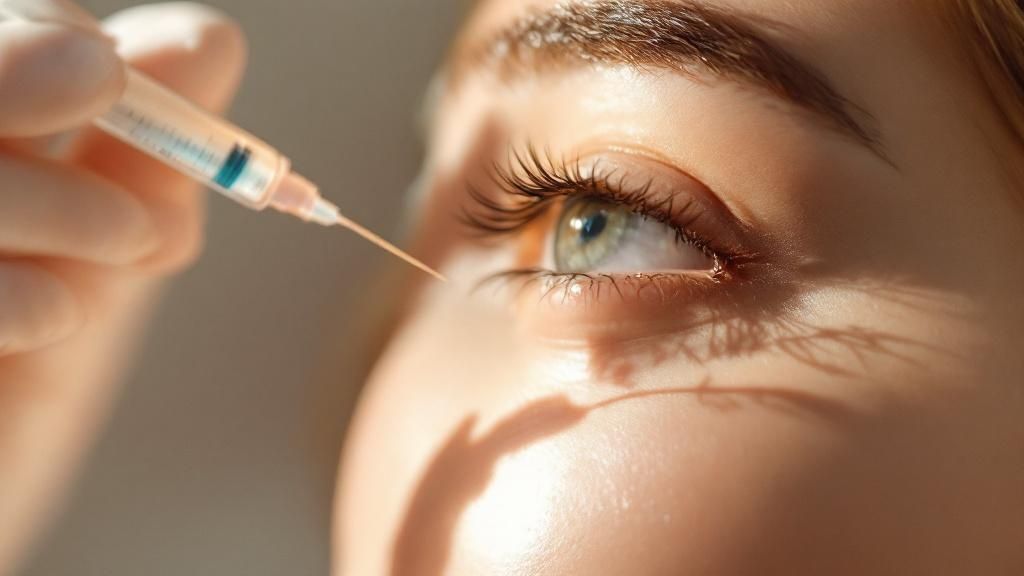
We all know aging plays a big part in under-eye bags, but what about when you see them on friends, family, or even yourself long before any wrinkles show up? This is where your genetics and natural facial structure step onto the scene. For many of us, the tendency to get puffiness is simply written into our DNA.
Think of your face’s anatomy as a unique blueprint. If your parents or grandparents had prominent under-eye bags, there's a good chance you’ve inherited the same structural traits that make them more likely to appear.
These aren't just about skin type. We're talking about the very architecture of your face—the bones, fat pads, and tissues that play a huge role in how that delicate under-eye area looks.
Your Inherited Facial Blueprint
Certain anatomical features can create the perfect storm for puffiness and shadows, no matter how much sleep you get or how clean your diet is. These aren't flaws; they're just beautiful variations in facial structure.
Here are the key inherited factors at play:
- Deep-Set Eyes: If your eyes are naturally set deeper into your sockets, it can create hollows and shadows that make even the slightest puffiness look more pronounced.
- High Cheekbones: While often seen as a desirable feature, the sharp contrast between high cheekbones and the soft tissue underneath can make the under-eye area appear sunken or hollow.
- Natural Fat Distribution: Your genes decide where your body stores fat, including those small pads around your eyes. Some people are simply born with more prominent fat pads in that area.
- Skin Thickness: Inheriting naturally thin skin under the eyes means the blood vessels and underlying structures are more visible, which can contribute to a darker, puffier appearance.
Your bone structure is a massive genetic factor. For instance, features like a less prominent midface bone (maxilla) can cause under-eye hollows and bags to show up early, even in young adults. It's a perfect example of how your natural anatomy—not your lifestyle—can be the root cause. You can read more about these structural findings here.
Understanding this genetic link is actually quite empowering. It helps you set realistic expectations and realize that sometimes, the best strategy involves targeted care designed for your unique anatomy. A product like the BARB N.P. Eye Contour Cream can help firm and hydrate this delicate area, effectively managing the appearance of genetically influenced puffiness.
How Lifestyle Choices Affect Puffy Eyes
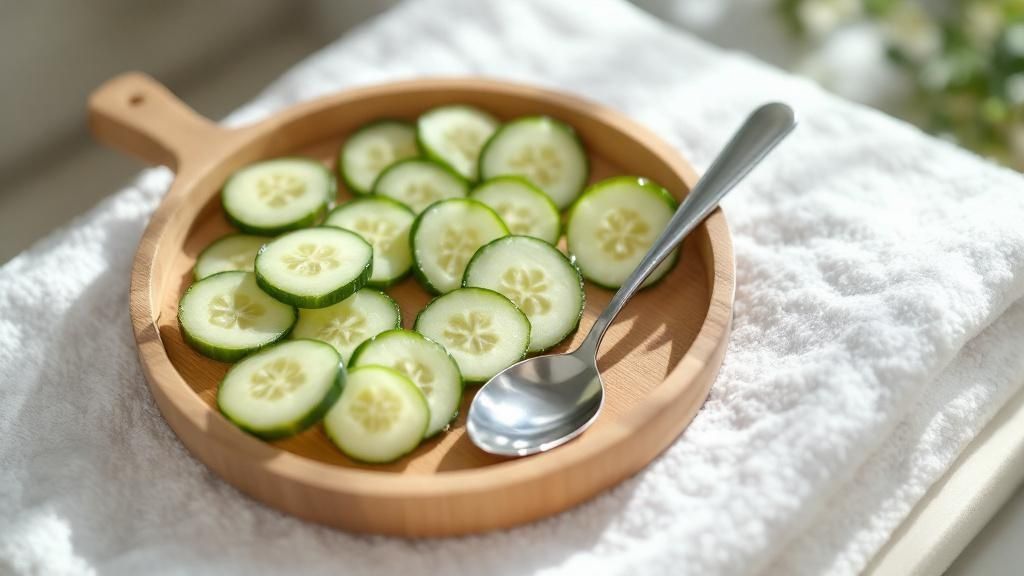
While you can’t change your genetics or turn back the clock, your daily habits have a huge say in what you see in the mirror. Many of the most common lifestyle choices are direct triggers for puffy eyes, and understanding them is the first real step toward making a difference.
Think of your body as a finely tuned system. When certain habits throw it off-kilter, the thin, sensitive skin under your eyes is one of the first places to show the strain.
The Sleep and Diet Connection
It’s no surprise that a rough night’s sleep can leave you with puffy eyes. When you’re sleep-deprived, your body can release stress hormones that degrade precious collagen. At the same time, fluid can pool in the tissues under your eyes, causing that telltale swelling.
This lack of rest leads to fluid retention and makes blood vessels more visible, making puffiness impossible to ignore. In fact, research on sleep and eye puffiness shows a clear link between irregular sleep patterns and under-eye swelling.
Your diet plays just as big a role. Salty foods are a major culprit behind what causes under eye bags. When you consume too much sodium, your body holds onto water to maintain balance, leading to puffiness that’s especially obvious in the delicate under-eye area.
"Many people underestimate how much their nightly routine and daily meals contribute to under-eye bags. Dehydration from alcohol or fluid retention from salt can dramatically worsen puffiness overnight."
Other Common Lifestyle Triggers
Beyond just sleep and salt, several other habits can make eye bags worse. Pinpointing these can help you build a smarter, more effective wellness routine.
- Smoking: This habit is a disaster for your skin. It accelerates collagen breakdown everywhere, but it’s especially destructive to the fragile skin around your eyes, inviting premature sagging and wrinkles.
- Alcohol Consumption: Alcohol is a diuretic, which is a technical way of saying it dehydrates you. Dehydrated skin loses its firmness, making the under-eye area look more sunken and shadowed.
- Seasonal Allergies: When pollen and other allergens kick your immune system into overdrive, your body releases histamines. This triggers swelling and fluid buildup, leaving you with itchy, puffy eyes.
By getting a handle on these factors and adding a targeted treatment like BARB N.P.’s Eye Contour Cream, you can actively fight back against lifestyle-induced puffiness and work towards firmer, healthier-looking skin.
Effective Treatments and At-Home Remedies
Now that we know what's behind those under-eye bags, let's talk about how to deal with them. The good news is you have plenty of options, from simple daily habits to powerful skincare ingredients, that can genuinely reduce puffiness and firm up that delicate skin.
The most effective approach targets the root causes we’ve already covered, like fluid retention and thinning skin. It's all about finding what works for you and being consistent with it.
Simple At-Home Tactics
You can start making a real difference with just a few small tweaks to your routine. These tricks are easy to adopt and can give you both immediate relief and long-term improvements.
- Apply a Cold Compress: A chilled teaspoon, a cool gel pack, or even classic cucumber slices really work. The cold helps constrict blood vessels, which is a fast track to reducing swelling—especially first thing in the morning.
- Elevate Your Head: Gravity is not your friend when it comes to fluid retention. By propping your head up with an extra pillow at night, you help prevent fluid from pooling under your eyes while you sleep. Simple, but effective.
- Stay Hydrated and Mind Your Salt: This is a big one. Drinking plenty of water helps your body flush out the excess sodium that causes fluid retention. At the same time, cutting back on salty foods helps stop the puffiness from starting in the first place.
Targeted Skincare Solutions
While at-home remedies are a great foundation, targeted skincare is what really supercharges your results by delivering potent ingredients where they’re needed most. A high-quality eye cream is non-negotiable for addressing puffiness, supporting collagen, and keeping the skin firm and hydrated.
Think of a great eye cream as a specialized support system for the most delicate skin on your face. It’s formulated with specific ingredients that tackle the multiple factors behind under-eye bags.
Keep an eye out for these powerhouse ingredients on the label:
- Caffeine: Famous for its vasoconstrictive properties, caffeine helps tighten the skin and reduce fluid buildup. It's the go-to ingredient for a quick depuffing effect.
- Peptides: These are the essential building blocks for proteins like collagen and elastin. Peptides signal your skin to ramp up production, helping to firm and strengthen the under-eye area over time.
- Hyaluronic Acid: A hydration hero, this ingredient draws moisture into the skin. This plumps it up, which helps smooth out fine lines and gives the skin a more supple, resilient texture.
For a formula that brings these key actives together, we recommend the BARB N.P. Eye Contour Cream. It’s specifically designed to firm the delicate under-eye area, visibly reduce puffiness, and lock in deep, lasting hydration.
And for those looking into more advanced clinical options, you can learn more about unlocking the secrets of under eye PRP treatments on our blog.
Your Questions About Under-Eye Bags, Answered
Let’s cut through the noise and tackle the questions I hear most often from clients about those pesky under-eye bags. Getting clear, straightforward answers is the first step toward building a routine that actually works.
Can Drinking More Water Really Help?
Yes, but it’s less about chugging a gallon of water before bed and more about consistent hydration. When your body is dehydrated, it goes into survival mode and clings to every last drop of fluid it can—which often shows up as puffiness under your eyes.
Staying consistently hydrated helps your system flush out excess sodium, a major culprit behind fluid retention. Think of it as keeping things flowing smoothly. This also helps maintain your skin's natural elasticity, making the whole area look plumper and less swollen. The key is steady sips throughout the day.
How Long Until Eye Creams Work?
This is where patience becomes your superpower. While some ingredients, like caffeine, can give you a temporary tightening effect almost immediately, the real, lasting changes happen over time. Ingredients designed to rebuild your skin’s foundation, like peptides that support collagen, need weeks of consistent use to work their magic.
For a high-quality eye cream, you should start to see noticeable improvements in skin texture and firmness after 4 to 8 weeks of daily use. Remember, consistency is far more important than how much product you slather on. A great option like BARB N.P.'s Total Eye Restore uses fast-acting depuffing agents alongside long-term firming peptides for both immediate and lasting results.
At What Age Do Under-Eye Bags Appear?
There’s no magic number here, and honestly, a lot of it comes down to genetics. Some people might notice puffiness starting in their early 20s simply because of their inherited facial structure.
For most of us, though, under-eye bags become more of a concern in our late 30s and early 40s. This is when the natural decline in collagen and elastin really starts to pick up speed, causing the skin to lose its firmness.
Are There Permanent Solutions?
For a truly permanent fix, a surgical procedure called a blepharoplasty (an eyelid lift) can remove or reposition the fat pads that create that bulge. It's a significant step, but it's the most definitive solution.
However, there are many incredible non-surgical treatments that offer significant, long-lasting results. And if dark circles are your primary concern along with bags, targeting them with the right ingredients is crucial. We break down some of the most effective options in our guide to SkinCeuticals A.G.E. Advanced Eye cream.
At BARB N.P., we believe in a smart combination of powerful at-home care and expert clinical treatments. Explore our curated selection of medical-grade skincare to find the perfect solution for your under-eye concerns. Shop our collection now.

